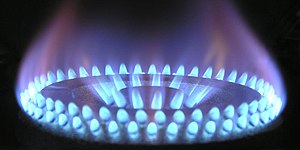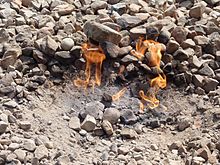 Global Information
Global InformationNatural gas information


Natural gas (also called fossil gas, methane gas or simply gas) is a naturally occurring mixture of gaseous hydrocarbons consisting primarily of methane (97%)[1] in addition to various smaller amounts of other higher alkanes. Low levels of trace gases like carbon dioxide, nitrogen, hydrogen sulfide, and helium are also usually present.[2] Methane is colorless and odorless, and the second largest greenhouse gas contributor to global climate change after carbon dioxide.[3] Because natural gas is odorless, odorizers such as mercaptan (which smells like sulfur or rotten eggs) are commonly added to it for safety so that leaks can be readily detected.[4]
Natural gas is a fossil fuel and non-renewable resource that is formed when layers of organic matter (primarily marine microorganisms)[5] decompose under anaerobic conditions and are subjected to intense heat and pressure underground over millions of years.[6] The energy that the decayed organisms originally obtained from the sun via photosynthesis is stored as chemical energy within the molecules of methane and other hydrocarbons.[7]
Natural gas can be burned for heating, cooking,[8] and electricity generation. It is also used as a chemical feedstock in the manufacture of plastics and other commercially important organic chemicals and less commonly used as a fuel for vehicles.
The extraction and consumption of natural gas is a major and growing contributor to climate change.[9][10][11] Both the gas itself (specifically methane) and carbon dioxide, which is released when natural gas is burned, are greenhouse gases.[12][13] When burned for heat or electricity, natural gas emits fewer toxic air pollutants, less carbon dioxide, and almost no particulate matter compared to other fossil and biomass fuels.[14] However, gas venting and unintended fugitive emissions throughout the supply chain can result in natural gas having a similar carbon footprint to other fossil fuels overall.[15]
Natural gas can be found in underground geological formations, often alongside other fossil fuels like coal and oil (petroleum). Most natural gas has been created through either biogenic or thermogenic processes. Biogenic gas is formed when methanogenic organisms in marshes, bogs, landfills, and shallow sediments anaerobically decompose but are not subjected to high temperatures and pressures. Thermogenic gas takes a much longer period of time to form and is created when organic matter is heated and compressed deep underground.[16][6]
During petroleum production, natural gas is sometimes flared rather than being collected and used. Before natural gas can be burned as a fuel or used in manufacturing processes, it almost always has to be processed to remove impurities such as water. The byproducts of this processing include ethane, propane, butanes, pentanes, and higher molecular weight hydrocarbons. Hydrogen sulfide (which may be converted into pure sulfur), carbon dioxide, water vapor, and sometimes helium and nitrogen must also be removed.
Natural gas is sometimes informally referred to simply as "gas", especially when it is being compared to other energy sources, such as oil, coal or renewables. However, it is not to be confused with gasoline, which is also shortened in colloquial usage to "gas", especially in North America.[17]
Natural gas is measured in standard cubic meters or standard cubic feet. The density compared to air ranges from 0.58 (16.8 g/mole, 0.71 kg per standard cubic meter) to as high as 0.79 (22.9 g/mole, 0.97 kg per scm), but generally less than 0.64 (18.5 g/mole, 0.78 kg per scm).[18] For comparison, pure methane (16.0425 g/mole) has a density 0.5539 times that of air (0.678 kg per standard cubic meter).
- ^ "Composition of natural gas: Understanding its key elements".
- ^ "Background". Naturalgas.org. Archived from the original on 9 July 2014. Retrieved 14 July 2012.
- ^ Kashtan, Yannai S.; Nicholson, Metta; Finnegan, Colin; Ouyang, Zutao; Lebel, Eric D.; Michanowicz, Drew R.; Shonkoff, Seth B.C.; Jackson, Robert B. (15 June 2023). "Gas and Propane Combustion from Stoves Emits Benzene and Increases Indoor Air Pollution". Environmental Science & Technology. 57 (26): 9653–9663. Bibcode:2023EnST...57.9653K. doi:10.1021/acs.est.2c09289. PMC 10324305. PMID 37319002.
- ^ "Why Does Natural Gas Smell Like Rotten Eggs? | Metropolitan Utilities District".
- ^ "How Natural Gas Is Formed | Union of Concerned Scientists". www.ucsusa.org. Retrieved 3 May 2022.
- ^ a b "Natural gas explained". U.S. Energy Information Administration. Retrieved 30 September 2020.
- ^ "Electricity from Natural Gas". Archived from the original on 6 June 2014. Retrieved 10 November 2013.
- ^ "We need to talk about your gas stove, your health and climate change". NPR.org. Retrieved 3 May 2022.
- ^ Valerie Volcovici; Kate Abnett; Matthew Green (18 August 2020). "Cleaner but not clean - Why scientists say natural gas won't avert climate disaster". Reuters.
- ^ "Data and Statistics: CO2 emissions by energy source, World 1990-2017". International Energy Agency (Paris). Retrieved 24 April 2020.
- ^ Hannah Ritchie; Max Roser (2020). "CO₂ and Greenhouse Gas Emissions: CO₂ Emissions by Fuel". Our World in Data. Published online at OurWorldInData.org. Retrieved 24 April 2020.
- ^ "Why carbon dioxide isn't the only greenhouse gas we must reduce – Dr Richard Dixon". www.scotsman.com. 27 July 2020. Retrieved 17 August 2020.
- ^ "Methane Emissions in the Oil and Gas Industry". American Geosciences Institute. 16 May 2018. Retrieved 1 May 2019.
- ^ "Natural gas and the environment". U.S. Energy Information Administration. Retrieved 30 September 2020.
- ^ "Natural gas is a much 'dirtier' energy source, carbon-wise, than we thought". Science. 19 February 2020. Archived from the original on 18 February 2021. Retrieved 3 April 2022.
- ^ "Organic Origins of Petroleum". US Geological Survey. Archived from the original on 27 May 2010.
- ^ "Natural gas". Lumen. Retrieved 1 March 2022.
- ^ Perry, Robert; Chilton, Cecil, eds. (1973). Chemical Engineers' Handbook. pp. 9–12.